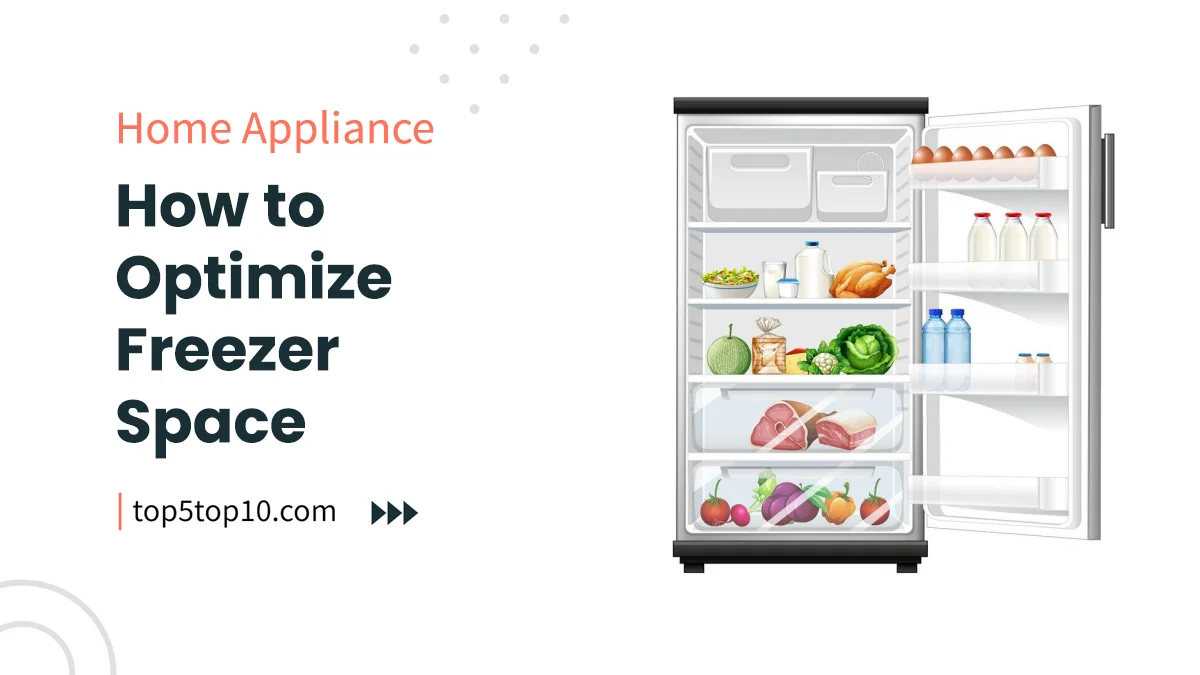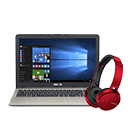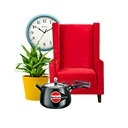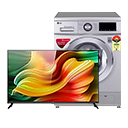
How to Optimize Freezer Space Effectively – A well-organized freezer is a game-changer when it comes to meal planning, reducing food waste, and making cooking more convenient.
Maximizing your freezer space efficiently not only saves you money but also helps you stay organized. In this comprehensive guide, we’ll explore how to optimize your freezer space effectively, step by step.
Contents
- 1. Assess Your Freezer Needs
- 2. Declutter and Prioritize
- 3. Invest in Proper Storage Containers
- 4. Organize by Zones
- 5. Use Space-Saving Techniques
- 6. Keep an Inventory
- 7. Practice FIFO (First In, First Out)
- 8. Monitor Temperature and Humidity
- 9. Regular Maintenance
- 10. Conclusion
- How to Optimize Freezer Space Effectively FAQs
1. Assess Your Freezer Needs
Understanding Your Freezer’s Capacity
To begin, let’s assess your freezer’s capacity and limitations.
Knowing what you’re working with is crucial for effective organization. Below, we break down common freezer types and their characteristics:
- Capacity: Typically ranging from 200 to 500 liters or 7 to 20 cubic feet.
- Limitations: Requires regular defrosting to prevent ice buildup.
- Capacity: Varies significantly, with some models offering as much as 500 liters or 20 cubic feet.
- Limitations: Known for deep storage, manual defrosting is usually required.
3. Combination Freezer (Top/Bottom or Side-by-Side)
- Capacity: Varies widely depending on the refrigerator’s overall size.
- Limitations: Limited freezer space compared to dedicated freezers.
Understanding your freezer’s type and capacity will be the foundation for an effective organization strategy.
Table 1: Freezer Capacity Assessment
| Freezer Type | Capacity (in liters or cubic feet) | Limitations (e.g., frost-free) |
|---|---|---|
| Upright Freezer | 200 | Requires regular defrosting |
| Chest Freezer | 500 | Deep storage, manual defrost |
| Combination Freezer | Varies | Limited freezer space |
2. Declutter and Prioritize
Streamlining Your Freezer Contents
Before you can optimize your freezer, it’s essential to start with a clean slate. Here’s a detailed decluttering process:
1. Empty the Freezer
Begin by removing all items from your freezer. This step allows you to clean the freezer thoroughly and assess the contents.
2. Check Expiry Dates
As you go through your frozen items, make sure to discard anything that has exceeded its expiration date. This step helps reduce food waste and frees up valuable space.
3. Prioritize Items
Now, sort your remaining items by frequency of use and expiration dates.
Items that you use most frequently should be easily accessible, while those with longer shelf lives can be stored further back.
Table 2: Freezer Declutter Checklist
| Step | Action |
|---|---|
| 1. Empty the Freezer | Remove all items from the freezer. |
| 2. Check Expiry Dates | Discard items past their expiration dates. |
| 3. Prioritize Items | Sort items by frequency of use and prioritize. |
3. Invest in Proper Storage Containers
Choosing the Right Freezer Storage Solutions
Investing in proper storage containers and bags is crucial for maintaining food quality and optimizing space. Here’s a closer look at the various options available:
1. Airtight Containers
Features: These containers seal in freshness and prevent freezer burn.
They come in various sizes and are perfect for items like soups, stews, and leftovers.
2. Freezer-Safe Bags
Features: Ideal for liquids and small items, these bags are designed to withstand freezing temperatures without becoming brittle.
3. Stackable Containers
Features: Stackable containers are designed to save space by allowing you to neatly stack multiple containers on top of one another.
Great for items like frozen berries and vegetables.
Labeling System
Features: Labeling your containers with contents and dates is essential for keeping track of what’s in your freezer. It also helps you identify items quickly.
Table 3: Types of Freezer Storage Containers
| Container Type | Features |
|---|---|
| Airtight Containers | Seal in freshness, prevent freezer burn. |
| Freezer-Safe Bags | Ideal for liquids and small items. |
| Stackable Containers | Save space by stacking neatly. |
| Labeling System | Label containers with contents and dates. |
4. Organize by Zones
The Importance of Freezer Zones
To make finding items in your freezer a breeze, consider dividing your freezer into specific zones. Here’s how to create an efficient zone system:
Sample Freezer Zones
- Meat Zone: Store items like beef, chicken, fish, and other protein sources in one section of your freezer.
- Vegetable Zone: Dedicate an area to frozen vegetables and herbs.
- Prepared Meals Zone: Keep leftovers and pre-cooked meals in a designated zone for quick and easy meal planning.
- Dessert Zone: Reserve space for ice cream and other frozen desserts, ensuring they remain easily accessible.
Creating these zones and grouping similar items together can significantly improve your freezer’s organization.
Table 4: Sample Freezer Zones
| Zone | Example Items |
|---|---|
| Meat Zone | Beef, chicken, fish. |
| Vegetable Zone | Frozen vegetables, herbs. |
| Prepared Meals Zone | Leftovers, pre-cooked meals. |
| Dessert Zone | Ice cream, frozen desserts. |
5. Use Space-Saving Techniques
Maximizing Every Inch of Space
Space-saving techniques are essential to make the most of your freezer’s limited space. Here are some effective strategies:
1. Vertical Shelving
Description: Install additional shelves or racks within your freezer to stack containers vertically. This optimizes space and makes it easier to see and access items.
2. Vacuum-Sealing
Description: Vacuum-sealing reduces the size of bulky items and prevents freezer burn. It’s particularly useful for meat, vegetables, and leftovers.
3. Flattening and Stacking
Description: Flatten items like pancakes, bread, and pizza slices before freezing them. Stacking these flat items takes up less space and allows for better organization.
Table 5: Space-Saving Techniques
| Technique | Description |
|---|---|
| Vertical Shelving | Install shelves for stacking containers vertically. |
| Vacuum-Sealing | Reduce bulky items’ size and prevent freezer burn. |
| Flattening and Stacking | Flatten items like pancakes and stack for efficiency. |
6. Keep an Inventory
The Power of a Freezer Inventory
Maintaining an inventory list is a game-changer when it comes to optimizing your freezer space. Here’s how to create and use one effectively:
Table 6: Freezer Inventory Sample
| Item | Quantity | Date Added | Notes |
|---|---|---|---|
| Chicken Breasts | 2 packs | 10/15/2023 | |
| Spinach | 1 lb | 10/20/2023 | |
| Homemade Lasagna | 1 portion | 09/28/2023 | Label as “Lasagna #1” |
| Blueberries | 2 cups | 10/05/2023 |
Maintaining a freezer inventory helps you track what’s inside, making meal planning a breeze.
7. Practice FIFO (First In, First Out)
Reducing Food Waste with FIFO
The FIFO (First In, First Out) method ensures you use older items before newer ones.
This simple technique reduces food waste and helps maintain the quality of your frozen goods.
Table 7: FIFO Example
| Item | Quantity | Date Added | Date Removed |
|---|---|---|---|
| Chicken Breasts | 2 packs | 10/15/2023 | 11/01/2023 |
| Spinach | 1 lb | 10/20/2023 | 11/10/2023 |
By following FIFO, you ensure that nothing gets buried and forgotten in your freezer.
8. Monitor Temperature and Humidity
The Science of Freezing
Maintaining the right conditions in your freezer is essential for preserving food quality. Here are some guidelines:
1. Freezer Temperature
Ideal Conditions: Keep your freezer at a consistent temperature of -18°C (0°F) or lower.
This temperature range prevents bacterial growth and maintains the freshness of your food.
2. Moisture Control
Use Moisture-Absorbing Packets: Consider using moisture-absorbing packets to prevent freezer burn, especially for items with high water content.
By paying attention to temperature and humidity, you can ensure your freezer preserves food at its best.
Table 8: Freezer Temperature and Humidity Guidelines
| Aspect | Ideal Conditions |
|---|---|
| Freezer Temperature | -18°C (0°F) or lower |
| Moisture Control | Use moisture-absorbing packets to prevent freezer burn. |
9. Regular Maintenance
Ensuring Longevity and Efficiency
To keep your freezer operating efficiently and prolong its lifespan, regular maintenance is essential.
Here’s a checklist to help you stay on top of freezer care:
Freezer Maintenance Checklist
- Defrosting: Perform defrosting as needed. Check for frost buildup, and if necessary, defrost your freezer to maintain optimal performance.
- Check Seals and Gaskets: Inspect the door seals and gaskets for wear and tear. Replace them as needed to ensure an airtight seal, which helps maintain temperature and prevents energy waste.
Table 9: Freezer Maintenance Checklist
| Maintenance Task | Frequency |
|---|---|
| Defrosting | As needed (check for frost build-up). |
| Check Seals and Gaskets | Annually or when signs of wear appear. |
10. Conclusion
An optimized freezer is a kitchen ally that can save you time, money, and reduce food waste.
By assessing your freezer’s capacity, decluttering, investing in proper storage, organizing with zones, employing space-saving techniques, keeping an inventory, practicing FIFO, monitoring temperature and humidity, and performing regular maintenance, you can maximize your freezer’s potential.
Remember, an organized freezer not only makes meal planning easier but also ensures your frozen food stays in its best condition.
Start implementing these tips today, and you’ll enjoy a well-organized and efficient freezer experience that enhances your daily cooking routine while reducing food waste and saving you money in the long run.
How to Optimize Freezer Space Effectively FAQs
What is the best way to organize and optimize freezer space effectively?
The key to optimizing freezer space is organization.
Start by labeling and dating items to keep track of what's inside. Use clear bins or baskets to group similar items, and stack or store items vertically to maximize space.
Regularly declutter and remove items that are no longer needed.
How should I arrange frozen food items to make the most of the freezer space?
Arrange frozen items with the most frequently used items at the top or within easy reach.
Store similar items together, and use containers or bags to minimize wasted space. Ensure items are properly sealed and airtight to prevent freezer burn.
Should I invest in a chest freezer for extra freezer space?
chest freezer can be a great investment if you have a lot of frozen items to store. They offer additional space and are energy-efficient.
Consider one if you regularly freeze large batches of food, have a garden with produce to freeze, or like to stock up on frozen goods.
What are some tips for preventing freezer burn and preserving food quality?
To prevent freezer burn, use airtight containers or vacuum-sealed bags for items you plan to store for a long time.
Remove excess air from bags before sealing. Label items with dates and use a first-in, first-out system to ensure older items are used first.
How do I keep track of what's in my freezer?
Keeping an inventory list of the items in your freezer is an effective way to stay organized.
You can use a simple spreadsheet, a dedicated app, or a paper list on your freezer door. This helps you know what's inside and prevents items from being forgotten and left to freezer burn.
|
Related Tags
freezer tips, extra freezer space, how to organise freezer drawers, top freezer organization ideas, freezer organization hacks, how to organize freezer side by side, freezer hacks, freezer organization chart
Last update on 2024-05-12 at 06:46 / Affiliate links / Images from Amazon Product Advertising API














